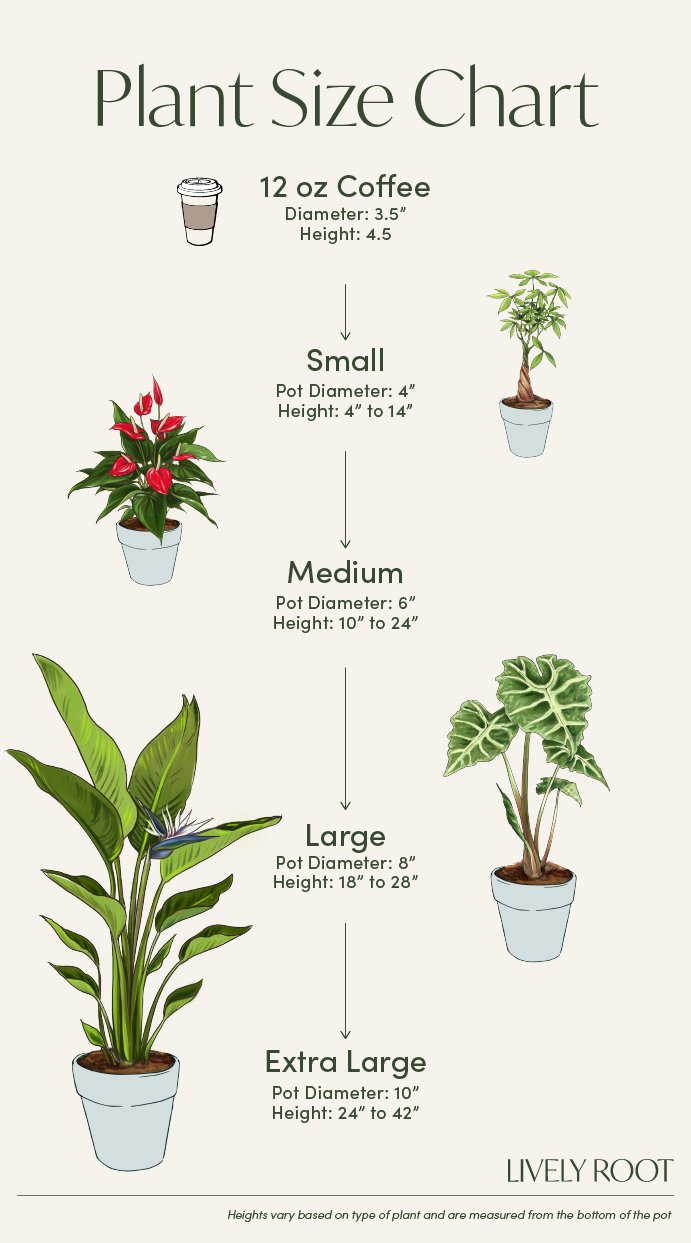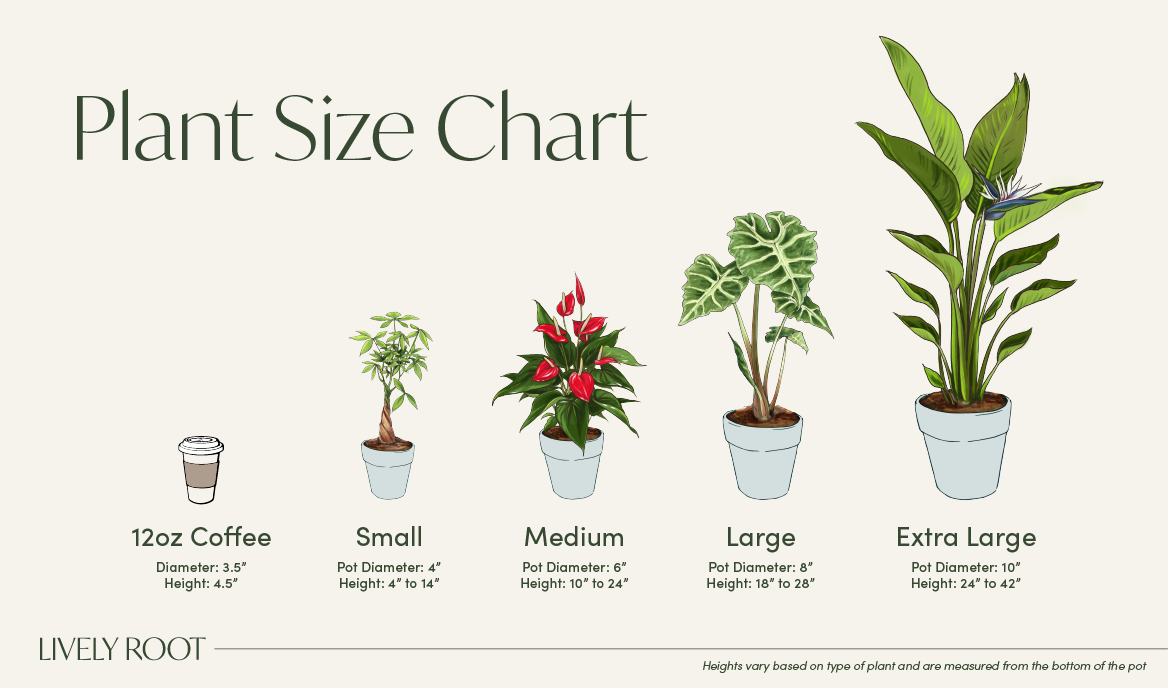

The Money Tree (Pachira Aquatica), commonly known as the Pachira plant or braided money tree, is the most popular Feng Shui plant, revered for bringing good luck and fortune wherever they go. Whether you're looking for a small or medium money tree, a large money tree, or even an extra-large one, these tropical indoor plants are not only symbols of prosperity but also incredibly easy to care for. Moreover, Money Trees are the ideal starter plants and make a fantastic housewarming gift. Place it in sunny spaces to watch it thrive while purifying the air.
Money Tree Care Guide & Presentation

Bright, indirect light to filtered sun.
Allow the soil to dry out completely between waterings.
Enjoys moderate to high levels of humidity. Spritz occasionally.
Ideally, the Money Tree likes the room temperature at 72°F. They handle warmth rather than cold so keep them away from cold drafts.
Outside: Grow in morning light, partial shade (4-6 hours) where nights are above 45°F.
Indoors: The Money Tree prefers bright, indirect light for at least six hours in a southern, eastern and western windows.
Fertilize bimonthly during their growing period. Use a balanced liquid fertilizer at 1/2 strength. Reduce during the fall and winter months while the plant is in their dormant phase and refrain from watering as much so they can rest.
When receiving the plant, do not repot immediately but wait at least 6-12 months or if the roots are beginning to get crowded and growing through the drainage holes.
Repot in the spring, using a 2" bigger pot to keep the roots drier. (Too big of a pot could cause the soil to dry slower, which is not helpful.) Use a well-draining indoor potting mix with perlite to help with drainage. Water your plant in the old pot before transferring over and let sit an hour. Place a piece of screening at the bottom of the container over the drainage hole to secure the soil and allow to drain.
Add soil to the bottom to elevate the root ball. Lift the plant and release the roots against the existing planter. Use a clean knife or garden trowel to wedge between the pot and the soil to loosen. Inspect the root ball. Notice if there are any dead or rotting roots and trim off with sterile pruners. If the plant is rootbound, cut through the roots to alleviate continued encircling. Ensure the plant is sitting about 1" below the edge of the pot to avoid water spillage. Add more soil and backfill around the sides by tamping down. Fill up to the soil line but not over. Water thoroughly, leaving the soil damp but not soggy. If settling occurs, add more soil.
Prune the leaves to stimulate new growth by cutting in front of a leaf node. Trim off any dead or damaged stems to keep them healthy.
Stem Cutting: In early summer, take a stem cutting, use sharp pruners to remove a cutting from a tip off the vine. Cut at least 4-6 inches of stem to propagate. Place in a vase with water to root. Change the water each week with filtered, bottled, or tap water sitting at least 24 hours. After 3-4 weeks, check to make sure the stem has 1-2 inch, well-formed roots. If so, it is time to plant. *Fill a small container with drainage holes (too large of a container for the cutting will make it challenging to regulate watering needs) using an indoor well-draining potting mix. Mix a little rooting hormone into the soil. Poke a hole in the soil with a pencil. Then, place the cutting in the hole and tamp the soil down around them. Water the plant and keep them in medium to bright indirect sunlight. After 4-6 weeks, the roots should establish.

FAQs
Money Tree Plant: Overview
The Money Tree (Pachira aquatica) is a beautiful plant with glossy, deep-green leaves. It has a woody trunk formed by several intertwining stems, giving it its unique braided shape. The money tree plant belongs to the Malvaceae family, which includes a variety of plants from flowering mallows and Hibiscus to edible plants like okra and cacao. Pachira aquatica originates from the swamplands of Central and South America. Growing in the wild, this hardy plant lives for decades, often reaching up to 60 ft in height. As an indoor plant, the money tree can reach 8 ft. tall. It loves bright, indirect light and enjoys some extra humidity.
The Pachira money tree is an ideal low-maintenance plant for homes with cats and dogs, as it’s non-toxic to pets. Moreover, this lovely indoor tree is considered one of the most powerful luck-bringing plants in Feng Shui. It is associated with prosperity and symbolizes good fortune, making it the perfect gift plant to convey your best wishes on various occasions, including weddings, moving into a new home, or starting a new job.
Pachira Aquatica: Benefits
- Excellent air-purifier
- Wonderful pet-friendly houseplant
- Gorgeous focal point plant
- Lucky plant in Feng Shui
- Easy to care for plant, ideal for beginners
Money Tree Care Guide
Although the Pachira plant isn’t fussy, knowing the basics of money tree care is essential to keep your plant happy and thriving:
Watering
While the money tree likes to be watered consistently, provide good drainage to prevent the soil from getting soggy. For the best results, use filtered or distilled water. Only water your money tree when the top 2-4 inches of soil are completely dry. Alternatively, get a plant in a smart self-watering planter to hel you meet your Money Tree's water needs hassle-free.
Light and Temperature
The Pachira plant prefers bright, indirect light, as direct sunlight can scorch its leaves. It grows best at room temperature, from 65°F to 75°F. If you want to grow your money tree plant as a porch plant, keep it in partial shade, and move it indoors when night temperatures are expected to fall below 50°F.
Humidity
The money tree requires some extra humidity. Place a pebble tray under the plant’s pot or mist your plant occasionally to increase moisture in the air around it. You can also group your plants to help them benefit from the transpiration of other plants, creating a microclimate of their own.
Soil, Repotting, and Fertilizing
When you get a Pachira aquatica tree, you don’t need to transplant it immediately. In the spring, repot your money tree into a pot 2 inches larger than the previous one. Ensure the pot has enough drainage holes, and use a well-draining potting mix. Add perlite to enhance drainage. The money tree doesn’t require frequent repotting, and if you don’t want it to grow large, keep it in a smaller pot. Feed your Pachira aquatica twice a month with a balanced liquid fertilizer at half-strength during the growing season.
Propagation
You can propagate your money tree plant from cuttings in early summer. Place the cuttings in a transparent vase filled with water until roots develop. Then, plant the young money trees in well-draining soil. Braiding your propagated cuttings is easy. Choose at least three young plants with flexible trunks and weave them gently together. Then, tie them with a ribbon at the top to let your braided money tree adjust to its new shape.
Pruning, Cleaning, and Common Issues
Prune your money tree to remove any damaged or wilted leaves to promote the growth of new leaves. Some common money tree issues include browning leaves due to underwatering. An overwatered plant, on the other hand, shows signs of yellowing leaves. Pest infestations are another common problem with Pachira aquatica plants.
Money Tree: Placement, Companion & Alternative Plants
Whether you buy a large money tree or a small bonsai version, these lovely plants will enhance your home’s indoor air quality and share their vitality and charm.
Best Locations & Uses
- Great for plant lovers with pets
- It is ideal for beginner indoor gardeners or people with busy schedules
- Perfect office or bedroom plant because of its air-purifying qualities
- A good luck plant that brings prosperity
- The ultimate housewarming gift plant
Companion Plants
Grouping plants with similar growing requirements to Pachira aquatica care needs will help you create an effortless indoor jungle! So, add to your money tree delivery the following easy-care tropical plants:
- Peace Lily Plant (Spathiphyllum): A low-maintenance choice, the Peace Lily is great at filtering toxins out of the air and, in addition to its lush foliage, produces gorgeous white spadix flowers!
- Swiss Cheese Monstera (Monstera adansonii): With its unusual holey leaves, the Swiss Cheese Monstera is both a climber and a perfect plant for hanging baskets.
- Philodendron Birkin Plant (Philodendron 'Birkin'): A beautiful plant with unusual variegated leaves, the Philodendron Birkin is a stunning addition to any home garden.
Alternative Plants
If you’re unsure about getting a money tree plant for sale, check out similar air-purifying plants that will add freshness and greenery to your living space:
- Lucky Bamboo Plant (Dracaena sanderiana): Known for its excellent air-purifying properties, the Lucky Bamboo Plant is also a highly popular luck-bringer in Feng Shui.
- Good Luck Plant (Cordyline fruticosa ‘Glauca’): The slender stalk and wide, curved leaves of the Good Luck Plant are elegant and ornamental, making it a perfect highlight in your plant display.
- Magenta Cane Dragon Tree (Dracaena marginata): With its vivid red-edged foliage, the Magenta Cane Dragon Tree is a beautiful and easy-care indoor tree that will add a tropical note to any living area.
Money Tree: FAQ
Q: Where is the best place to put a money tree?
A: To bring abundance and good luck into your home, place your money tree in a southeast area of your home. Money trees thrive in bright to medium indirect light, protected from cold drafts.
Q: What does it mean to gift a money tree?
A: Gifting a money tree means you wish someone good luck. Traditionally, the money tree symbolizes prosperity, financial success, and good fortune. It also makes the perfect housewarming gift.
Q: How many leaves on a money tree are good luck?
A: Money trees usually have 5 or 6 leaves on each stem. Finding stems with 7 leaves is rare and considered very lucky.
Q: Should money trees be braided?
A: Braided money trees are believed to enhance positive energy and good fortune. The braided money tree's unique sculptured appearance adds aesthetics and symbolizes strength and growth, thus increasing the chance of attracting wealth to your home or business.
Order a Lucky Money Tree for Sale From Lively Root
Invite good fortune and enhance your home’s air quality with a gorgeous Pachira aquatica for sale from Lively Root!
































































































































